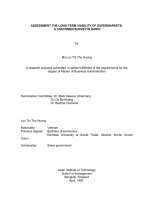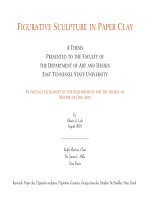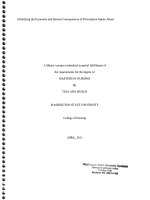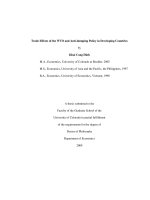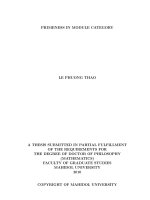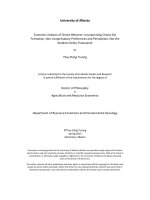Presented in Partial Fulfillment of the Requirements for graduation with distinction in Economicsin the College of Social and Behavioral Sciencesat The Ohio State University
Bạn đang xem bản rút gọn của tài liệu. Xem và tải ngay bản đầy đủ của tài liệu tại đây (2.48 MB, 71 trang )
The Social Capital Effect on Economic Growth
A Senior Honors Thesis
Presented in Partial Fulfillment of the Requirements
for graduation with distinction in Economics
in the College of Social and Behavioral Sciences
at The Ohio State University
By
José Mustre del Río
The Ohio State University
May 2005
Project Adviser: Eric O'N. Fisher, Associate Professor
Department of Economics
Acknowledgements
The author would like to thank Dr. Eric Fisher for his infinite patience and
wisdom through out this project and the rest of the faculty at Department of Economics at
The Ohio State University for comments and support. Furthermore, the author would like
to thank Dr. Gene Mumy and Dr. Timothy Frye for their comments and help as thesis
committee members. The author would also like to thank comments from conference
participants at the 2005 Carroll Round Conference at Georgetown University. Finally, the
author extends his humble appreciation and gratitude to his parents, Marcela and José, for
their endless guidance and support throughout his entire education and furthermore,
thanks to Jessica Ford for her unconditional support.
2
Table of Contents
1.Introduction
pg. 5
2.Review of the Literature
pg. 8
2.1. Bowling Alone: The Collapse and Decline of American Community pg. 8
2.2. The Road to Serfdom
pg. 12
2.3. Does Social Capital Have an Economic Pay-off?
pg. 14
3.Initial Results
pg. 15
3.1. Expectations A Priori
pg. 15
3.2. The Model and Basic Results
pg. 19
3.3. IV and 2SLS Regressions
pg. 23
3.3.1. Technical Digression: IV and 2SLS
pg. 23
3.3.2. Religion and Legal Origin as Instruments
pg. 25
3.3.3. Health and Age Distribution as Instruments
pg. 29
3.3.4. Crime, Lawyers and The Social Sciences
pg. 35
3.3.5. Ethnic Homogeneity as an Instrument
pg. 39
3.4. Expectations Revisited
4.Social Capital's Impact on Institutions
pg. 43
pg. 45
4.1. Democracy
pg. 45
4.2. Law and Order
pg. 48
4.3. Constraints on The Executive
pg. 50
4.4. Corruption
pg. 52
4.5. Contract Enforcement and Property Rights
pg. 54
3
4.6 Summary
pg. 58
5. Concluding Remarks
pg. 60
Data Appendix
pg. 65
References
pg. 69
4
1. Introduction
Recent economic and sociological research has suggested the importance of social
capital as a determinant of economic performance. In a seminal contribution to the body
of research, Putnam (1993) finds that local governments of Italian regions characterized
by strong civic participation, perform better when delivering public goods. Corroborating
Putnam's findings worldwide, La Porta et al. (1997) find that in a cross section of
countries, trust and civic engagement are associated with improvements in the
performance of firms and the government. Finally, Knack and Keefer (1997) find that in
a cross section of countries, trust and civic engagement have a significant positive effect
on economic growth even once controlling for other factors such as initial income and
educational level. These last two studies rely on trust and civic engagement data from the
World Value Surveys (WVS) of 1981 and 1990-1991 to quantify social capital.
In this investigation we propose a new measure of social capital and implicitly
ask: are the World Value Surveys reliable and do they measure social capital effectively?
These surveys could potentially be subject to cultural biases in responding and reporting
simply because there is no uniform standard of trustworthiness or because it is
cumbersome to translate notions of trustworthiness from one language to another. To
speak of trustworthiness in Chinese may not be the same as speaking of trustworthiness
in Italian and much less in Hausa. Furthermore, these surveys do not capture long-term
trends in social capital given that the surveys occur in two waves within a ten-year
interval. Thus, it is not clear whether the data of the World Value Surveys is the result of
a net change in social capital or merely opportune snapshots of the social climate in
5
countries around the world. Furthermore, the validity of inferences made based on such
limited data is questionable.
This study attempts to confirm the conclusions of the previously mentioned works
by using voter turnout in parliamentary elections as a measure of social capital, as
previously suggested by Putnam (2000). Our analysis differs from the previous two by
considering data over a fifty-year period (1950-2000), in an attempt to capture the effect
that social capital may have on long-run economic performance. In addition, our measure
of social capital is based on an observable behavior —voting— rather than a reported
belief—trust. By using Ordinary Least Squares (OLS) on our cross section of countries,
we attempt to estimate the effect that increasing voter turnout in parliamentary elections
has on economic growth, once other macroeconomic factors are controlled. Given the
nature of this study, it is possible that our dependent variable and one (or several) of the
independent variables are determined simultaneously leading to a bias in estimation if
this is not controlled. Also it is possible that our dependent variable causes the
independent variables leading to a reverse causation or endogeneity bias. To control for
these biases in estimation, we will use instrumental variable (IV) and two-stage least
squares (2SLS) techniques.
Our initial findings suggest that once other factors are controlled, voter turnout
does not have a significant effect on economic growth. This could be the result of one of
the following possibilities: (1) voter turnout is an inaccurate measure of social capital; (2)
social capital does not have a significant effect on long-run growth once other
macroeconomic variables are controlled; or (3) the mechanism through which voter
6
turnout (as a measure of social capital) influences long-run growth is not as direct as our
initial specification dictates.
Given La Porta et al.'s (1997) findings on the positive relationship between
performance of large organizations and social capital and, Knack and Keefer's (1997)
findings of a strong relationship between social capital and confidence in the government,
we examine the possibility that our measure of social capital improves government
performance. Following La Porta et al.'s (1997) framework we conclude that our measure
of social capital is very significant for government performance when using a variety of
measures of the perceived efficacy of the government. Following the widespread
literature on the fundamental importance of institutions for growth [e.g. Acemoglu et al.
(2004) or Hall and Jones (1999)], we suggest that the economic pay-off of social capital
is via increased government performance—concurring with (3) as mentioned above.
This thesis is divided as follows. In section 2 we present an overview of the
literature central to this investigation. In section 3 we present our baseline specification
and use it to estimate the effect of social capital on growth using OLS and IV/2SLS
techniques. In section 4 we consider one specific channel through which social capital
may indirectly induce growth—government performance. Finally, in section 5 we
conclude.
7
2. Review of the Literature
In this section we review the three main publications that this thesis is premised
on. Central to our discussion is Putnam's (2000) book Bowling Alone: The Collapse and
Decline of American Community. Given that much of our empirical work will hinge on
claims of this book, the first portion of this section will provide a brief overview of the
arguments of this work that are central to the analysis in section 3. Similarly, the second
portion of this section will provide an overview of Hayek's (1944) The Road to Serfdom.
Finally, we will review one of the most recent counterparts to our empirical analysis:
Knack and Keefer's (1997) article "Does Social Capital Have an Economic Pay-off?"
2.1 Bowling Alone: The Collapse and Decline of American Community
Based on social capital theory, Robert D. Putnam attempts to explain the decline
of civic and social life in American communities. He begins by explaining that the
central tenet of social capital theory is that social networks have value since social
contacts can affect the productivity of individuals and groups. "Social capital refers to
connections among individuals —social networks and the norms of reciprocity and
trustworthiness that arise from them (pg. 19)." Putnam goes on to explain that social
capital has both an individual and collective aspect. For individuals, social capital helps
to find jobs and companionship, while collectively social capital can have externalities
that affect a whole community rather than just the person making the contact.
In
addition, Putnam emphasizes that social connections are also important because they
foster norms of reciprocity. Particularly important to our future discussion is what
Putnam calls generalized reciprocity: "I'll do this for you without expecting anything
specific back from you, in the confident expectation that someone else will do something
8
for me down the road (pg. 21)." Putnam argues that "a society characterized by
generalized reciprocity is more efficient than a distrustful society, for the same reason
that money is more efficient than barter. If we don't have to exchange instantly, we can
get a lot more accomplished (pg. 21)"—this difference between social capital rich and
poor societies is what we test. In addition, Putnam argues that when economic and
political dealing is contained in dense social interaction, incentives to rent-seek are
reduced.
In support of his hypothesis of America's declining social capital, in chapter 2
Putnam shows the important decrease in political participation by Americans. To
motivate the importance of the decline in voter turnout, Putnam explains that "voting is
the most common form of political activity and it embodies the most fundamental
democratic principle of equality. Not to vote is to withdraw from the political community
(pg. 35)." Furthermore, he argues that voting is an instructive proxy measure of broader
social change: voters are more likely to be interested in politics, give to charity,
volunteer, participate in public demonstrations and to cooperate with fellow citizens on
community affairs. Putnam claims that recent work [i.e. Knack (1992), Conway (1991)
and McCann (1998)] suggests that voting itself encourages volunteering and other forms
of good citizenship.
In chapter 8, Putnam discusses reciprocity and trust. Putnam argues that trusting
communities have a measurable economic advantage since they reduce transactions costs.
Furthermore, Putnam argues that while a legal system can give us assurance of the good
faith of others another solution to this problem is generalized reciprocity, which can exist
in dense networks of social exchange.
Similar to voter turnout, social trust seems to
9
have peeked in the US in the mid 1960s and declined thereafter. As a measure of
trustworthiness and honesty, Putnam offers crime rates. He argues that crime maybe a
symptom of weakened social control and shows that crime rates began to rise sharply in
the middle of the 1960s at the same time as other measures of social capital and trust
began to decline. Again Putnam argues that an alternative to generalized reciprocity is the
rule of law and supports his claim by showing that starting in the 1970s the number of
lawyers in the US steadily increased. While it can be argued that this is the result of
increasing crime rates, there was no major growth in criminal law during this period.
Putnam states that the largest increase in demand for legal work was in the form of
"preventive lawyering" or the need to "get it in writing." Putnam argues that this reflects
America's heavy reliance on formal institutions rather than using informal networks
supported by generalized reciprocity.
Next and essential to our discussion, Putnam presents his "Social Capital Index"
in chapter 16. Using various independent measures, Putnam attempts to rate social capital
in the 50 states. Putnam's index includes measures of community organizational life,
engagement in public affairs, community volunteerism, informal sociability and social
trust. He goes on to argue that the fourteen indicators measure related but distinct facets
of social capital. Of particular importance to us is one of Putnam's engagement in public
affairs measure, voter turnout in presidential elections 1988 and 1992. While no single
measure can define a state's social capital, Putnam argues that interstate differences seem
to go together given the correlations of the individual measures with the overall index
(e.g. places with high electoral turnout tend to have high social trust). For example,
10
Putnam's measure of social trust has a correlation of 0.92 with the overall index while
turnout in presidential elections has a correlation of 0.84 with the overall index.
Also key to our analysis is Putnam's discussion of economic prosperity and its
relation to social capital in chapter 19. At the microeconomic level, Putnam argues that
social capital helps us surmount employment barriers and allows us to achieve social
status and economic rewards. As an example, Putnam compares the success of
California's Silicon Valley and demise of Boston's route 128. While route 128 maintained
traditional norms of corporate hierarchy, secrecy and self-sufficiency, Silicon Valley
entrepreneurs shared information, problem-solving techniques and created social clubs.
Putnam suggests that Silicon Valley's industrial system based on regional networking
allowed for flexibility and dynamic technological adoption as opposed to route 128 rigid
experimentation and learning confined within individual firms. According to Putnam,
industrial districts like Silicon Valley allow for information flows and economies of
scale. Putnam concludes the chapter by encouraging the view that social capital may
boost economic efficiency —benefiting all— albeit the unclear aggregate evidence.
Chapter 20 focuses on the importance of social connectedness on health and wellbeing. Putnam argues that social cohesion is beneficial for health since social networks
can provide tangible assistance that reduces physical and psychic stress. He also argues
that social networks may reinforce healthy norms—since isolated people are more likely
to smoke and drink— and that social capital may stimulate the immune system to fight
disease and stress. Putnam also cites work done at Harvard's School of Public Health,
which finds a strong link between physical health and social capital across the US. States
with fair or poor health were the same where residents distrusted others; states with low
11
scores on the "Social Capital Index" also had poor health and high all-cause mortality
rates. Putnam concludes that social networks allow us to stay healthy.
Finally, in chapter 21 Putnam mentions the role social capital plays in improving
democracy. Externally, social capital, in the form of voluntary organizations, allows
individuals to express their interests and demands on the government and provides
protection from abuses of political leaders. Internally, associations and networks of civic
engagement instill in their members habits of cooperation and public-spiritedness while
providing practical skills necessary for public life. In this sense, voluntary organizations
are "schools for democracy." Furthermore, Putnam suggests that social capital may
improve the functioning and accountability of the representative government. When
comparing the Northern and Southern regions of Italy, Putnam finds that in the Northern
regions—where social networks were organized horizontally and where solidarity, civic
participation and integrity are valued—democracy works. In the Southern regions
characterized by weak social engagement and cultural associations, the representative
government is less effective. Putnam also suggests that social capital matters for the
functioning of the government in the US. In social capital rich states, politics is more
issue oriented and apparently less corrupt.
2.2 The Road to Serfdom
In this work, Friedrich Von Hayek issues a warning regarding the political
direction that democracies such as the US and England are leaning towards after World
War II. Throughout this book Hayek expresses his concern that collectivism and social
planning can ultimately lead to the destruction of political and economic freedom. While
12
supporting individualism over collectivism, Hayek also provides arguments for the strong
correlation between democracy and economic growth.
Hayek explains that the gradual transformation from a rigidly organized
hierarchic system into one where men could attempt to shape their own life was closely
associated with the growth of commerce (1944, pg. 14). Hayek also argues that this
commercial growth "took firm root wherever there was no despotic political power to
stifle it. In the Low Countries and Britain it for a long time enjoyed its fullest
development and for the first time had an opportunity to grow freely and to become the
foundation of the social and political life of these countries (pg. 14-15)." Furthermore,
Hayek argues that during the modern period of European history "the general direction of
social development was one of freeing the individual from ties which had bound his
activities; the conscious realization that the spontaneous and uncontrolled efforts of
individuals were capable of producing a complex order of economic activities could only
come after this development had made some progress (pg. 15)." "The subsequent
elaboration of a consistent argument in favor of economic freedom was the outcome of a
free growth of economic activity which had been the undesigned and unforeseen byproduct of political freedom (pg. 15)." In addition, when talking about liberalism Hayek
argues that "the immediate improvement of liberalism had to rely largely on the gradual
increase of wealth which freedom brought about (pg. 19)." Stressing the importance of
democracy for freedom, Hayek quotes De Tocqueville's claim that "democracy extends
the sphere of individual freedom; socialism restricts it (pg. 25)." Thus, from Hayek's
work we can argue reverse causation and simultaneous determination of economic
13
growth and democracy since the development of one produces (and requires) the
development of the other.
2.3 Does Social Capital Have An Economic Pay-off?
In this article, Stephen Knack and Philip Keefer address empirically the question
of the impact social capital has on economic growth. Knack and Keefer use data from the
World Values Surveys (WVS) 1981 and 1990-1991 in creating their TRUST variable
representing social capital. TRUST is percentage of respondents in each nation replying
"most people can be trusted" when asked "generally speaking, would you say that most
people can be trusted or that you can't be too careful in dealing with people?" Knack and
Keefer find a strong and significant relationship between social capital and growth when
using this measure of social capital and controlling for human capital (primary and
secondary school enrollment), initial income (real GDP per capita in 1980) and the price
level of investment goods (relative to the US). Even when using ethnolinguistic
fractionalization and the number of law students in 1963 as a percentage of all
postsecondary students as instruments for social capital, TRUST remains a predictor of
growth.
Next Knack and Keefer consider channels through which trust may affect
economic outcomes. In particular, they consider the impact trust may have on property
and contractual rights and, the impact trust may have on government performance. When
controlling for human capital levels and initial income, Knack and Keefer find that their
TRUST variable is the only significant predictor of government performance (an index
based on data from the WVS). Similarly, when considering risk faced by foreign
investors Knack and Keefer find that TRUST significantly predicts this risk. Finally,
14
Knack and Keefer find significant relationships between TRUST and property rights
security and, TRUST and "executive constraints." Knack and Keefer then suggest that
trust may improve governmental efficiency and increase investors' confidence in contract
enforcement. However, they are unable to explain the direct path through which trust
affects economic performance since their property rights measures and confidence in the
government are borderline significant in growth regressions or investment regressions.
Therefore, while Knack and Keefer's intermediate findings are very promising, overall
they are unable to provide conclusive evidence for the mechanism through which social
capital can improve economic performance.
15
3. Initial Results
This chapter will present a series of specifications that attempt to measure the
social capital effect on economic growth. First, we will mention our expectations and
present our basic model. We continue by giving reasons for the construction of our model
and proceed with its estimation. After presenting our initial results, we show the
robustness of them with IV and 2SLS techniques. Finally, we will conclude the chapter
by attempting to coalesce our expectations and empirical findings.
3.1 Expectations A Priori
In this subsection we will present our expectations prior to any regression
analysis. First, we will support voter turnout as a measure of social capital with previous
findings in the literature. Then we will present some graphical evidence that suggests the
feasibility of our expectations. Finally, we will highlight our main expectations.
According to Knack and Keefer (1997, pg. 4) "knowledge of politics and public
affairs by large numbers of citizens, and their participation, are important potential
checks on the ability of politicians and bureaucrats to enrich themselves or narrow
interests that they are allied with." Putnam (2000, pg. 35) argues that "voting is the most
common form of political activity, and it embodies the most fundamental democratic
principle of equality. Not to vote is to withdraw from the political community." As a
measure of social capital Putnam (2000, pg. 35) stresses that: "voting is an instructive
proxy measure of broader social change. Voters are more likely to be interested in
politics, give to charity, volunteer, serve on juries, attend community school board
meetings..." However, Putnam (2000) later admits that voting and following politics are
relatively undemanding forms of participation and strictly speaking are not forms of
16
social capital since they can be done alone (pg. 37). For this reason it is possible that
voting may in fact overstate the stock of social capital in a nation.
Given Knack and Keefer's (1997) results on the strong association between trust,
civic norms and stronger economic performance, our initial suspicion is that we may be
able to find a positive relationship between our measure of social capital —voter
turnout— and economic performance. In constructing the "Social Capital Index" for his
US study, Putnam (2000) finds a strong correlation between his index and voter turnout
(0.84). The analogue of Knack and Keefer's (1997) TRUST variable in Putnam's (2000)
index has a correlation of 0.92 with the overall index (the strongest for any single
component). When comparing our measure of social capital to the trust data from the
World Values Survey used in constructing the TRUST variable in Knack and Keefer
(1997), we find a modest correlation of 0.45. Graphically this relationship is depicted in
figure 1.
Thus, given Putnam's (2000) and Knack and Keefer's (1997) findings there is: (1)
evidence that voter turnout may be useful as a measure of social capital; and (2) evidence
that social capital in fact has an effect on growth. However, since voting can be done
alone (as mentioned above) we must emphasize that our measure of social capital can
overstate the actual level of social capital and hence inflate our results. Therefore, if we
find statistically significant results in favor of a social capital effect on growth, these
should be understood as upper bounds of the true effect. As a prologue to our series of
statistical tests, we plot the relationship between the logarithm of GDP per capita in 2000
and voter turnout in figure 2, finding a reasonably linear relationship between the two.
17
1
ITA
BEL
AUS
voter turnout
.6
VEN
NOR
FIN
URU
ARG
TUR
DEN
NED
.8
ATR
UK
IRE
JAP
FRA
CAN
IND
NIG
BRA
PER
MEX
.4
SWI
USA
.2
COL
0
20
40
TRUST
60
Figure 1.
USA
CAN
JAP
FRA
10
SWI
TRI
logGDP2000
8
9
MEX
BRA
THA
COL
ELS
GUA
NORATR
DEN
IRE
NED
FIN
AUS
BEL
UK
NZL
ISR
ITA
ARG
URU
VEN TUR
COS
PER
SRL
NIC
7
BOL
IND
HON
6
NIG
.2
.4
.6
voter turnout
.8
1
Figure 2.
18
3.2 The Model and Basic Results
In this subsection we will present our formal model and basic results. First we
will present the model and give reasons for its construction. Next, we report our initial
results. Finally, we discuss shortcomings of our model.
Similar to Knack and Keefer's (1997) baseline specification, our proposed model
is the following:
(1) logGDPi
2000
where: logGDPi
€
= β0 + β1votei + β2 log ki
2000
2000
+ β 3 log GDPi
1950
+ β 4 enrolli + ε i
is the logarithm of real GDP per capita in the year 2000 (acting as
our measure of income); β0 is the intercept term (constant over all countries); votei is our
€
voter turnout measure; log ki
2000
is the natural logarithm of the approximate capital stock
€
€
1950
per capita in 2000; logGDPi
is the logarithm of the initial real GDP per capita; enrolli
€
is the gross secondary enrollment ratio averaged over 1960-2000 and ε i is the classical
€
error term.
€
€ al.'s (1997) specifications,
Following Knack and Keefer's (1997) and La Porta et
we assume that the intercept term is constant over all countries, implying an equal
income level for all countries when none of the explanatory variables are present and no
country specific or time specific exogenous shocks to income exist. Rather than
controlling for the price level of investment (relative to the US) as in Knack and Keefer
(1997), we control for the capital stock of each country, since differences in capital stocks
can help explain differences in income and since we are trying to follow the growth
specifications proposed by Mankiw et al. (1992). As our measure of social capital, we use
voting in parliamentary elections to represent voter turnout instead of voting in
presidential elections. Choosing the latter would restrict the list of countries included in
19
our analysis given that not all countries have an executive power embodied in a president,
yet many do have a legislative power. Specifically, our measure of voter turnout is the
number of votes divided by the voting age population figure [since this is the type of
voter turnout figure used in constructing Putnam's (2000) "Social Capital Index"]. We
include the gross secondary enrollment ratio as a measure of human capital, given that a
more human capital can induce stronger growth (Barro, 1991). Finally, the initial level of
real GDP per capita, logGDP1950 is included in our specification to control for
convergence. Our baseline specification essentially implies that the ideal country from
€
our dataset produces
output based on endowments of physical capital, human capital and
social capital. The error term in this model represents immeasurable factors such as
technological advances. The results of running OLS on this baseline specification appear
in Table 1.
Table 1 Dependent Variable logarithm of GDP per capita 2000
Method
OLS
Independent Variables
votei
log ki
€
€
€
€
€
2000
enrolli
logGDPi
β0
1950
-0.23
(-0.77)
0.68**
(11.54)
0.32
(1.19)
0.15♦
(1.90)
1.54**
(2.81)
N=36
R2=0.96
Notes: t-ratios in parentheses. ♦significant at 10% level *significant at 5% level
**significant at 1% level.
20
Our initial regression implies a negative and insignificant relationship between
voter turnout and growth. The relatively high p-value for vote (0.45) reflects its
inadequacy as an explanatory variable of growth. At this point, it is important to mention
€
the effect of compulsory voting laws on voter turnout. While many countries do have
compulsory voting laws with penalties ranging from minor fines to possible
imprisonment, rarely are these laws enforced. When including dummy variables for
compulsory voting laws and variables that measure the level of enforcement of these laws
in unreported regressions, we systematically fail to reject that the coefficients on these
variables are not statistically significant from 0. Thus, in order to avoid irrelevant
variable biases in our regressions, we do not include them.
As expected, a larger capital stock reflects higher income per capita. In particular,
our estimated coefficient (interpreted as an elasticity) implies that a 1% increase the
capital stock of the year 2000 will increase income per capita by roughly .68%. In
addition, the significant and positive coefficient on the initial level of GDP per capita
implies that countries will not converge conditionally.
An 11% increase in GDP per
capita of 1950 results in an increase in income in the year 2000 by .15%. While this at
first may be surprising, the heterogeneity in final income levels of our data set suggests
historical divergence of incomes between the richest and poorest countries in our sample.
Our initial results would support Pritchett's (1997) findings of considerable divergence in
incomes between the richest countries in the world and the rest. Furthermore, our
estimated coefficient may reflect that divergence in economic performance can only
captured in the long-run (such as our examined 50 year period) while 20-year studies may
capture some convergence. Also since our dependent variable is final income, the
21
coefficient on initial income implies no beta convergence, which does not contradict
previous findings of sigma convergence.
Surprisingly, we find that our human capital measure is insignificant—i.e.,
increases in secondary enrollment are not associated with increases in income. While this
is inconsistent with our prior expectations and other results in the literature, we can offer
an explanation for the insignificance human capital in our regressions. It is very likely
that better educated countries will tend to vote more and participate in other civic
activities more (relative to less educated countries) since civic responsibility can be
instilled through schooling. Furthermore, Barro (1991) finds that initial human capital has
a positive effect on physical investment leading us to believe that human capital may
have a similar effect on our capital stock measure. Thus, it is possible that part of
education's explanatory power on final income is being shared by our social capital and
physical capital measures. In our sample of countries, human capital is correlated with
social capital and physical capital with correlation coefficients of 0.57 and 0.79
respectively.
A process that we are overlooking and which may be affecting our voter turnout
coefficient is the simultaneity between growth in incomes and voter turnout, due to the
latter acting as a measure of political and personal liberty. From Hayek's (1944)
discussion on the evolution of personal liberty and economic prosperity we can suggest
that economic growth and political freedom are determined simultaneously. Putnam
(2000) argues that "voting embodies the most fundamental democratic principle of
equality," while Hayek (1960) points out that equality in front of the law and in making
the law is the where the ideas of democracy and liberalism meet. Thus, we can argue that
22
higher voter turnout reflects a stronger democracy where individual liberty is upheld.
Hence, there may be some reverse causality between rising incomes and voter turnout as
the latter may represent the level of democracy in a nation.
3.3 IV and 2SLS Regressions
To circumvent the reverse causality and simultaneity biases, in the next
specifications we attempt two stage least squares (2SLS) and instrumental variables (IV)
techniques to estimate the effect that voter turnout may have on final income. With this
approach, we should be able to isolate the true exogenous effect that voter turnout has on
income. This in turn could change our initial results and provide empirical evidence in
favor of Putnam's claim that voting is an instructive proxy for social capital. First, we will
have a technical digression on how IV and 2SLS work. Then, we will use a series of
instruments and present results when using each instrument.
3.3.1 Technical Digression: IV and 2SLS
Instrumental variables (IV) and two-stage least squares are regression techniques
used whenever one or several of the independent variables in a regression are
endogenous—i.e. not predetermined and thus not orthogonal to the error term. Given the
assumptions of the classical linear model, a regressor not being orthogonal to the error
term is equivalent to the regressor having as non-zero correlation with the error term:
Cov(ε i , xij ) = E[xijε i ] − E[xij ]E[ε i ] = E[xijε i ] ≠ 0 , since E[ε i ] = 0. This poses a problem
when using OLS to estimate a linear equation because coefficient estimates will be biased
€
€
since the strict exogeneity assumption of OLS will be violated. Non-zero correlation with
the error term can arise in the following situations: when xij is measured with error, xij is
€
€
23
simultaneously determined with the dependent variable or similarly, the dependent
variable causes xij .
The instrumental variables (IV) technique circumvents these problems by using a
€
predetermined
(exogenous) variable that is correlated with xij (endogenous regressor) to
estimate a consistent estimate of the coefficient on xij . As an example, if we are
€
estimating yi = α 0 + α1 xi + ε i , where xi is correlated with the error term, the IV estimator
€
of α1 would be:
€
Cov(zi , yi )
ˆ
α1,IV =
Cov(zi , xi )
€
€
where zi is an exogenous variable called the "instrument" of xi . Intuitively, the IV
€
estimator is a measure of the correlation between the endogenous regressor xi and
€
€
dependent variable yi deflated or weighed by the portion of xi which is not determined
€
by yi . As mentioned above this determination can be through measurement error,
€ or reverse causation.
simultaneity
€
€
Another procedure that can be used to avoid endogeneity biases is two-stage least
squares (2SLS). This procedure is called 2SLS since it entails running two regressions: in
the first stage the endogenous variable is regressed on an instrument(s) and a constant to
obtain fitted values of the endogenous variable. In the second stage, these fitted values
are used to estimate the original equation. In our previous example, the first stage would
consist of estimating xi = γ 0 + γ1zi + vi with OLS and then calculating the fitted values, xˆi .
In the second stage, we would use the fitted values to estimate yi = α 0 + α1 xˆi + ε i to obtain
€
€
a consistent estimate of α1 . When using 2SLS we assume that the error terms in the first
€
€
24
and second stages are uncorrelated. In general, the 2SLS estimator can be written as an
IV estimator when using the appropriate instruments (Hayashi, 2000).
3.3.2 Religion and Legal Origin as Instruments
In this subsection, we will use religion and legal origin as instruments for social
capital. First, we will discuss why is religion is a viable instrument and proceed with the
estimation of our model using 2SLS. Second we will emphasize the usefulness of legal
origin as an instrument for social capital and also estimate our model using 2SLS.
Putnam (1993) argues that hierarchical religions discourage "horizontal" ties
between people and therefore the formation of trust or social capital. La Porta et al.
(1997) find a negative correlation (-0.47) between the percentage of Catholics in a
country and trust. For our sample of countries and measure of social capital the
correlation has the same direction but not as strong (-0.31). This relationship is plotted in
figure 3. The correlation between the incidence of Muslim people and voting is minimal
(.0184), however this figure is misleading since our group of countries is predominantly
Catholic with very low percentages of Muslims. Given that the percentage of Catholic
and Muslim people in a country reflects cultural attitudes and preferences rather than
economic conditions and preferences, we believe that these figures can serve as good
instruments primarily because they should not be determined by contemporaneous
economic conditions. Furthermore, La Porta et al. (1997) have also used religion as an
instrument for social capital. Using 2SLS we estimate the following set of equations:
(1) logGDPi
2000
= β0 + β1votei + β2 log ki
(2) votei = γ 0 + γ1catholici
1980
2000
+ γ 2 mus lim i
+ β 3 log GDPi
1980
1950
+ β 4 enrolli + ε i
+ υi
€
€
25
